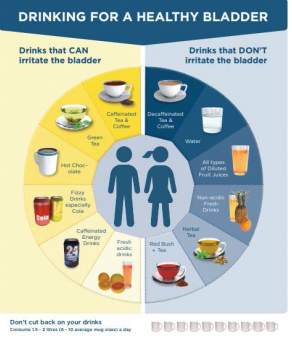Download and print as a PDF (514kB pdf)
On this page
What is bladder training?
Bladder training is a way of managing the sudden and very intense need to pass urine which you cannot control (urinary urgency), needing to empty the bladder with only a short time between visits (frequency) and or passing urine unintentionally (urinary incontinence).
Urinary urgency, frequency and / or incontinence can develop overtime as a result of poor bladder habits or they can be triggered byfactors such as medication use, hormonal changes, caffeine andnicotine. However, sometimes there is no specific cause.
Bladder training teaches you techniques so you can control your bladder habits more easily and hold on for longer between visits to the toilet. Over time, bladder retraining will stop you needing to rush to the toilet so frequently and will help you to regain a normal bladder emptying pattern.
Bladder capacity
Your bladder is a muscular organ that expands slowly as it fills with urine. Normal bladder capacity is roughly between 300 to 600 mls (between a mug and a pint). You can overstretch your bladder if you do not empty it often enough. Over time, your bladder gets used to holding more volume which can affect its ability to empty properly. This can lead to bladder infections or kidney problems.
If you empty your bladder too often, this causes the muscle to be under stretched. This means that you will need to visit the toilet more often as your bladder will find it difficult to hold a normal volume of urine. The more you go, the more you will need to go, as your bladder gets used to holding less and less urine. With this in mind, try to cut out any ‘just in case’ visits to the toilet.
How much fluid should I drink in a day?
It is recommended that you drink approximately 1.5 to 2 litres of fluid per day (6 to 8 glasses). During the course of the day it is normal to visit the toilet approximately every three hours (this should roughly match the number of drinks you have). Remember the recommended fluid intake includes all drinks including water. As part of your management you may be encouraged to complete a chart over three days, measuring what you drink and the amount of urine you pass. This will help to guide your individual treatment plan.
How can I help my bladder control?
Some activities, such as running tap water, putting your key in the door when you arrive home and standing in a toilet queue, can increase your symptoms. The following techniques can be used to help you to re-train your bladder. You may experience some discomfort at first and progress may take some time, but if you persevere this will improve.
When you feel the urge to void try the following techniques
• Stand still or sit down and squeeze your pelvic floor muscles. If you are unsure how to find your pelvic floor muscles see POGP Pelvic Floor Muscles (for women).
• Stand on tip toes.
• Firmly squeeze or rub the back of your thighs.
• Distract your thoughts by fixing your mind on something else or concentrate on your breathing, making each breath calm and regular.
Wait until the urgency passes.
What should I drink and other advice?
Certain drinks can irritate your bladder and cause you to pass urine more frequently. The most common irritant is caffeine which is found in coffee, tea, green tea, coke and energy drinks. It is worth swapping these for decaffeinated versions to see if this improves your bladder symptoms.
Other reported bladder irritants are:
• Alcohol.
• Fizzy drinks.
• Drinks containing artificial sweeteners.
• Citrus drinks: orange, grapefruit and lemon.

If you tend to get up in the night to empty your bladder, avoid drinking for at least two to two and a half hours before bedtime.If you do wake at night don’t automatically get up. Try to ignore the urge and use some of the techniques listed in this information.
Who do I contact for further information?
The information in this leaflet is for guidance purposes only and is in no way
intended to replace professional clinical advice by a qualified practitioner.